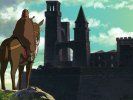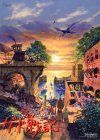Eye For Film >> Movies >> Tales From Earthsea (2006) Film Review
I am a devoted fan of the Earthsea novels, with happy childhood memories of gradually understanding more and more of the deep, inspirational and epic themes and meanings of this great series. When my favourite animation studio announced they were adapting the Earthsea books, my heart soared.
Tales from Earthsea is an adaptation of the popular novels by Ursula K Le Guin, which predate Harry Potter by almost 40 years. These stories follow the personal and spiritual journey of a complex and contradictory mage called Sparrowhawk (Ged), from humble beginnings to his ascension to the rank of Archmage and beyond. The novels and associated short stories are beautiful, complex and redolent with big themes and archetypes both mythic and Jungian.

The magic of Earthsea depends on the secret knowledge of the true names of things. With that knowledge a wizard or sorcerer can summon, alter, or even unbind an item - unbinding is strictly forbidden. When Lord Cob, a wicked and misguided sorcerer, tries to preserve his own life to an unnatural length, he sets in motion an unbinding that threatens the very fabric of Earthsea. Wizards begin to forget the true names, craftsmen put aside their craft, and all art and lore is forgotten and scorned as mere trickery and illusion. The very balance between the realms of Shadow and Light is threatened and the Land begins to die.
Goro Miyazaki, son of the master animator Hayao Miyazaki (Spirited Away, Howl's Moving Castle), displays a woeful inexperience and incompetence in storytelling. Tales From Earthsea evidences little of the elder Miyazaki's skill and patience.
What we have is a choppy and disjointed effort to adapt the third and possibly fourth novels. We have some of the elements of a successful Ghibli studio animation: a personal adventure against a half-epic backdrop, hand-drawn visuals and splendid painted backdrops.
To be fair it starts reasonably well. I initially believed Miyazaki would tell us the Archmage Sparrowhawk's story in flashback. However, they have decided to start at the end of the original trilogy. I settled down to enjoy an adaptation of the most deeply philosophical of the books. It was not to be.
During the movie the young hero, Prince Arren, acts strangely, with multiple personalities. This behaviour and the reasons for it were originally an important part of developing Sparrowhawk's character; to ascribe it to Arren is a clumsy move. This behaviour is the apparent reason for a brutal murder. This doesn't belong - chiefly, it is against the original source material's character and it looks out of place in a Ghibli picture. To me this is the critical point where Miyazaki loses the audience, the resulting disjunction causing the narrative flow to fall apart.
In the books Sparrowhawk arrogantly attempts to open the Doorway between the realms of the living and the dead. This unleashes a shadow, a dark twin that pursues Sparrowhawk, and is the reason for his scar. He defeats it in the end but at great cost. Cob makes a similar mistake; so why, I ask myself, does Arren, a non Mage, have such a dark twin? It makes no sense to the casual viewer and to the true fan it is utter nonsense - thus the younger Miyazaki reveals his lack of empathy with the source material.
Character design is unoriginal - clearly cannibalising previous Ghibli works. Prince Arren resembles the male lead from Princess Mononoke. Therru, the female lead, is just another typical anime girl in appearance - although in a nice touch, the red mark on her eye matches and echoes Sparrowhawk's white scar. The head lackey of the evil wizard, Lord Cob, is hair-for-hair a clone of the idiotic henchman in Naussica of the Valley Of Wind. The extras all have toad-like faces, which smacks of laziness and a rushed production and development. The two visually interesting and strongly developed character designs are Sparrowhawk and Lord Cobb - who in the proud tradition of Japanese bad guys is designed to resemble a female vampire. One is reminded of the hermaphrodite tree spirit in A Chinese Ghost Story and Zoltarr from the popular Battle Of The Planets series.
There's a point to be made: there is little 2D animation evolution between this and 1988's Laputa: Castle In The Sky or earlier works such as Only Yesterday. It falls short of the hypnotic visuals of 2004's Howl's Moving Castle. This is rather disappointing and I suspect is the result of Goro-san's apparent impatience.
The backdrops, as previously mentioned, are another story. They are gloriously impressionistic: the artists bring the decadence of Hort Town and the grandeur of Enlad to life in colour worthy of a Blake or a Constable. Also, the gorgeous use of sunrise and sunset colours are key to the visual splendour of the movie. It is the naturalistic and gorgeous colours that are its main visual strength.
What we have then is a film that began with the best of intentions. If only the screenplay had lived up to expectations this would have been an animation landmark, but Goro Miyazaki tries to cram several decades of novels and short stories into two hours. The audience is left with a dense, underwritten train wreck that neither Ghibli fans nor Earthsea fans can recognise or entirely admire, and as a film on its own right it is rather lost at sea.
Tales From Earthsea is available in both subtitled and dubbed prints. I pity non-fans viewing this mess and trying to understand it - the only reason I had any clue what the soundtrack was gibbering about is that I knew the source material backwards. Subtitles are the order of the day, as there are moments where the dubbing is as muddy as the storytelling. For those desiring further insight into the background of this tragedy I suggest visiting Ursula Le Guin's website, where her acerbic and insightful comments will educate you in what happens when a writer trusts a studio too much. Read the books and short stories - they are much more wonderful than this.
Reviewed on: 26 Jul 2007




















